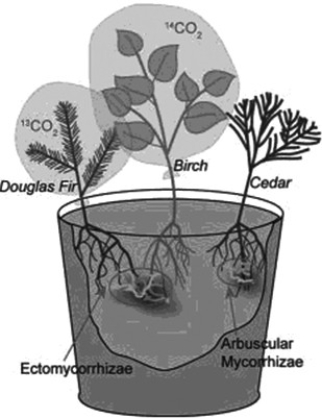Suzanne Simard and colleagues knew that the same mycorrhizal fungal species could colonise multiple types of trees. They wondered if the same fungal individual would colonise different trees, forming an underground network that potentially could transport carbon and nutrients from one tree to another (S. Simard et al. 1997. Net transfer of carbon between mycorrhizal tree species in the field. Nature 388:579-82) .
Pots containing seedlings of three different tree species were set up and grown under natural conditions for three years (Fig.A) . Two of the three species (Douglas fir, birch) could form ectomycorrhizal connections with the same fungal species, but the third species (cedar) could not form an ectomycorrhizal connection with the fungal species. In some of the pots, the researchers placed airtight bags over the Douglas fir and birch seedlings and injected carbon dioxide made from carbon-13 into the bags with the Douglas fir and carbon dioxide made from carbon-14 into the bags with the birch. (13C and 14C are different isotopes of carbon that can be detected and measured by researchers.) As the seedlings photosynthesised, the carbon dioxide was converted into sugars that could be tracked and measured by the researchers. The researchers measured whether the sugars in each plant contained only the carbon isotope that was in the air of their plastic bag or also the carbon isotope from the air around the other plant.
Figure A
-Referring to Simard et al. (1997) , which design element is the control in this experiment and why?
Definitions:
Meta-Analysis
A statistical analysis that combines the results of multiple scientific studies to arrive at a conclusion about a body of research.
Descriptive Technique
A research method used for observing and describing behavior in a natural setting without influencing it.
Statistical Procedure
A sequence of operations applied to a set of data to extract information, assess assumptions or test hypotheses.
Pseudoscience
Practices, beliefs, or methodologies that claim to be scientific and factual but lack empirical evidence, scientific method, or are incompatible with scientific research.
Q1: Compared to eukaryotes, prokaryotes are _.<br>A) less
Q3: Which of the following is not a
Q8: In onions (Allium), cells of the sporophyte
Q18: Molecular clocks are more reliable when _.<br>A)
Q20: Large animals need specialised organs for gas
Q24: Epiphytes are<br>A) fungi that attack plants.<br>B) fungi
Q29: Arrange the following structures, which can be
Q33: As you stroll through a moist forest,
Q53: Your professor wants you to construct a
Q77: Which of the following could be considered